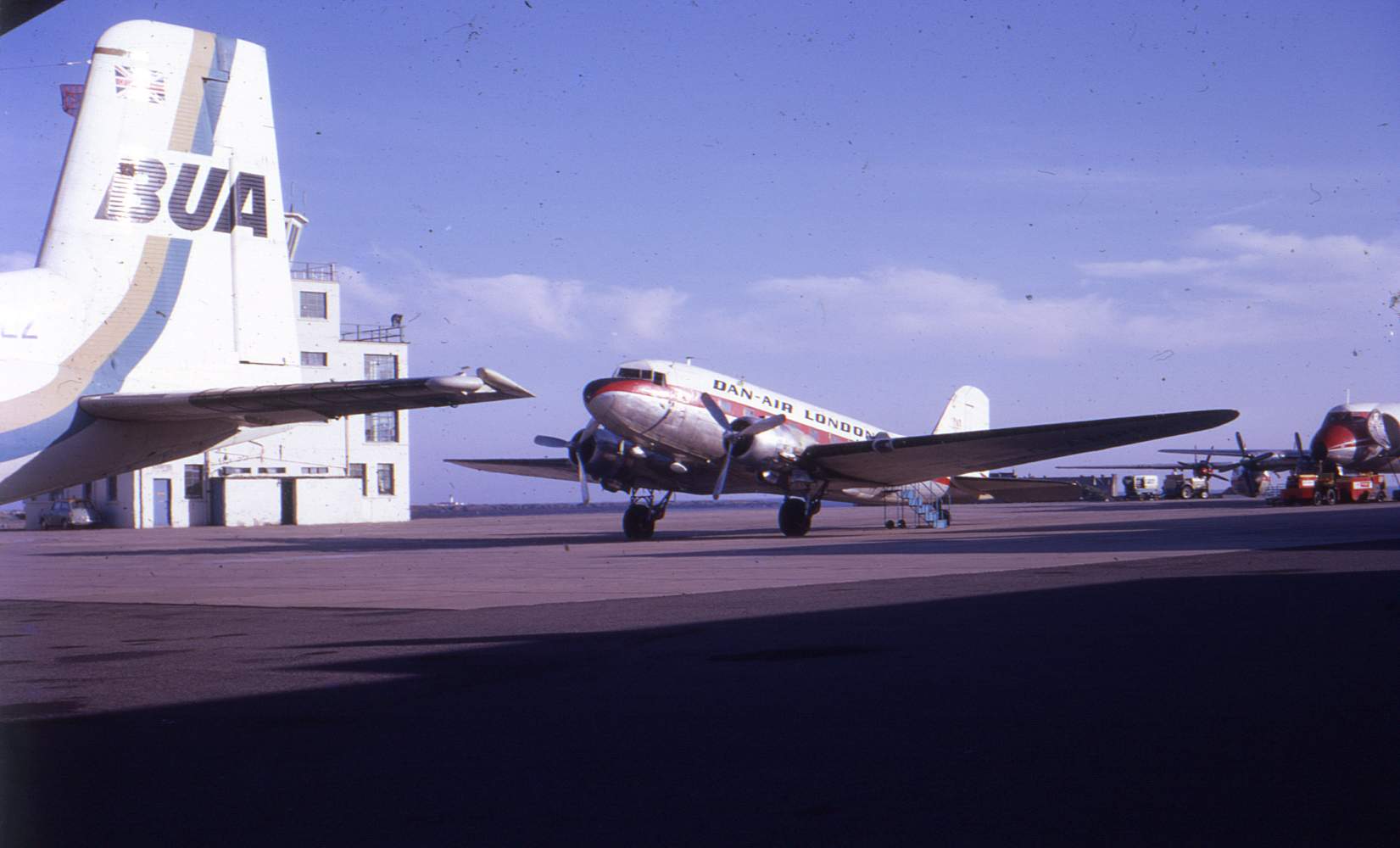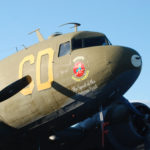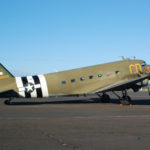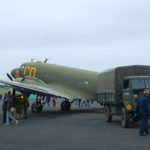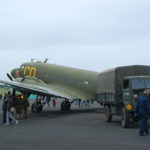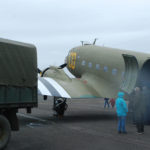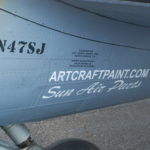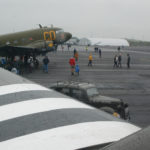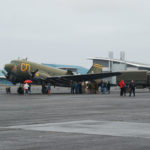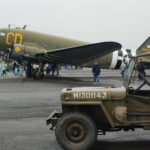Betsy’s Biscuit Bomber, N47SJ, is a C-47B-1-DK built at Oklahoma City as part of contract AC-40652 for 607 aircraft. Unlike the other aircraft of the Dakota Squadron, she has been a military girl all her working life and, as such, is one of the most original C-47s left – as well as being one of the lowest time airframes. The astrodome for star shots and drift meter for dead reckoning remain in place and very little of the upgrading seen in civil versions is apparent.
Betsy’s recorded USAAF history varies between sources, but the basics are that she rolled off the production line in March/ April 1944 with serial number 43-48608. Following delivery to Air Transport Command (1) at Roswell Army Air Force base, New Mexico on 4th September, she is reported to have completed the Atlantic crossing by October 1944 and to have been allocated to 27th Air Transport Group of the 302nd Air Transport Wing of the Air Service Command. A different timeline is quoted in Warbird Digest #50 based on an interview with Gary Corippo of Estrella Warbirds Museum (2). This version has Betsy delivered via Syracuse AAF base, New York State, and ferried across the Atlantic to arrive in England just after D-Day in time to be allocated to a Troop Carrier Wing. The differences have an important bearing on the aircraft’s subsequent WW2 history (discussed in the green section below, skip it if the complicated organisational changes of the USAAF are not for you!) and may have influenced her colour scheme since purchase by the Gooney Bird Group. Since her Israeli Defence Force camouflage was replaced with USAAF 1940s olive drab, Betsy has had two colour schemes since reaching Paso Robles: she visited Oshkosh in 2010, painted in olive drab with a nose code ‘U5’ and, for the Normandy Commemoration, she has the nose code ‘CD’ and the double yellow tail bar of the Air Service Command. If the former accurately reflects her history, she would have served with 81st Troop Carrier Squadron of 436th Troop Carrier Group, part of 53rd Troop Carrier Wing of IX Troop Carrier Command. As such she could have taken part in glider towing for Market Garden, supply drops at Bastogne and the 1945 Rhine Crossing. If the more recently-adopted colour scheme is correct (the current Estrella Warbirds site supports this), then it seems like she served with 27th Air Transport Group of 302nd Air Transport Wing which had very different duties and excitements. I’m sure interest following Betsy’s recent visit to Europe will have stimulated further historical discussion and detail.
Sources:
(1) ‘The Douglas DC-3 and its predecessors’ by JMG Gradidge, www.joebaugher.com both give a 4th September 1944 delivery date to Air Transport Command. The dates and allocation to the 27th Air Transport Group of 302nd Air Transport Wing are also recorded on the Gooney Bird Group’s website dedicated to Betsy’s story.
(2) Warbird Digest #50 featured Betsy’s Biscuit Bomber and an interview with Glen Corippo who was involved in bringing the aircraft to Estrella.
Background to US Military Air Transport during WW2 and the split between tactical (troop carrier) operations and logistical services.
In the early 1940s the air arm of the US armed forces was working hard to achieve the kind of autonomy enjoyed by the Royal Air Force. Politics, military and civil, had tended to retard the development of a service which had great potential on both the domestic and worldwide stage. There were numerous reorganisations which reflected the expansion of the US forces into various new theatres of war, changing relationships with allies and the development of airborne operations.
On 29th May 1941 the US Army Air Corps reacted to the Lend/ Lease act of March 1941 to form the Air Corps Ferrying Command which would assist with the delivery of aircraft to the RAF in Canada and beyond. Ferrying Command also involved themselves in passenger transport issues and, as the USA remained neutral, began to employ Pan American to deliver DC-3s to the British forces in West Africa. Converted B-24 Liberator bombers were borrowed from Combat Command and, on 1st July 1941, a passenger/ courier service was inaugurated between Washington and Prestwick, Scotland. It became known as ‘The Arnold Line’ after the Chief of the USAAC, General ‘Hap’ Arnold and, by Pearl Harbor, was operating 11 B-24s on this route.
The US Army Air Corps became the US Army Air Force on 20th June 1941 although its status was not elevated until 9th March 1942 when it became one of the three major components of the US Army.
On 17th October the Air Service Command was established from the Air Corps Maintenance Command, itself only activated on 15th March 1941.Based at Wright Field, Ohio, the function of Maintenance Command had been to supply logistics and maintenance to US air bases. Although their jurisdiction was considered to end at the airfield boundaries, the Command also included 50th Transport Wing, established on 14th January 1941 and tasked with moving military supplies between bases within the USA. This entailed moving huge volumes of freight, more than that carried by the civilian airlines combined.
The Japanese attacked Pearl Harbor on 7th December 1941 and the USA entered World War 2. Demands for military cargo intensified and civilian airline capacity was contracted to supplement the efforts of 50th Transport Wing. By early 1942 it was considered that the Air Service Command might take over all military air transport including ferrying. However, the reverse happened, with 50th Transport Wing transferred to a newly-created Air Transport Command at the end of April 1942. This was clearly not moving towards unified military air transport with Ferrying Command, Air Service Command and Air Transport Command all taking bites of the biscuit. This changed on 20th June 1942 when General Arnold issued General Order #8 which, confusingly, renamed Ferrying Command ‘Air Transport Command‘. It retained all ferrying responsibilities and, additionally, was to provide all air transportation for the War Department except for Troop Carrier operations. The Air Transport Command which had previously existed with 50th Transport Wing’s C-47s was renamed I Troop Carrier Command with responsibilities for glider towing, paratroop operations, air drops and equipment/ personnel transport within war zones. Thus the division was made between C-47s operating in Tactical and Support roles.
Despite its sweeping responsibilities, Air Transport Command initially relied heavily upon civilian crews to operate its 130+ strong fleet on military transport duties. Some aircraft were transferred from Air Service Command , some were added from new production and, after 6th May 1942, some civil DC-3s were impressed into air force service. By mid-1942 over 11,000 twin-engined transport aircraft were on order to satisfy the demands of the USAAF and American allies. Ferrying arrangements between the RAF and ATC had established ‘joint tenancies’ at 4 British airfields by Spring 1943: Prestwick, Nutts Corner (Belfast), Valley (Anglesey) and St Mawgan in Cornwall. By April 1943, the Air Transport Command was the main tenant at Prestwick.
The March 1942 circular #59 which had defined the USAAF’s new status also outlined a structure which would comprise eleven numbered air forces plus six support commands. Thus, by March 1943, the USAAF structure included Troop Carrier Command, Air Service Command, Air Transport Command, Material Command and Flying and Technical Training Commands. The initial four domestically-based numbered air forces was expanded to, firstly, eleven and then sixteen. The Eighth Air Force had located to the UK for European Theatre Operations and, from November 1942, the Ninth Air Force was deployed to the Mediterranean. Following the airborne assault on Sicily, July 1943, and mainland Italy, September 1943, combat groups of Ninth Air Force were combined with the Twelfth Air Force in the Med. The Ninth took over the Eighth Air Force’s medium bomber operations in Great Britain and moved their IX Air Force Service Command from the Mediterranean to Grove airfield in Oxfordshire in October 1943. From October 16th 1943 all US tactical air support in the UK was consolidated under Ninth Air Force control and IX Troop Carrier Command was formed. The function of the TCC was not logistical and the C-47s were dedicated to tactical operations and, as such, could be held in reserve for weeks. Logistical operations for the Ninth were handled by 31st Transport Group from its Grove base.
The Eighth Air Force also had their own Air Service Command dedicated to their specific needs and 27th Air Transport Group had operated from Hendon since Spring 1943. However, the USAAF still aimed to centralise logistical services and, on 1st September 1944, 31st and 27th Transport Groups were removed from the control of their respective air forces and combined as 302nd Transport Wing of what was then termed the US Strategic Air Forces Air Service Command. Although the 302nd had been established on 2nd November 1943 and activated just over a month later, it had no operational aircraft until assigned the 31st and 27th Transport Group’s C-47s in September 1944. By this date, 31st Transport group was already moving most of its operations to France in support of the allied advance. Normandy operations had been established at a forward airstrip at Colleville-sur-Mer from the end of July; by 31st August, the first transport aircraft had landed at a heavily bomb-damaged Orly Airport, Paris, a mere 4 days after the last German soldier had been expelled from the city. The 27th Transport Group had provided support to air force operations with flights between Hendon and destinations like Warton, Portreath, Langford Lodge, Burtonwood and Maghaberry. Since December 1943 there had been two flights daily between Prestwick and Hendon, effectively extending the Washington-Prestwick air link to London. This service was called the ‘Marble Arch Line’.
The IX Air Force Service Command had managed to retain 20 C-47s for its own purposes following the re-assignment of 31st Transport Group and this left 302nd Air Transport Wing short of aircraft. This had been anticipated and an extra 100 C-47s were rounded-up from factories and domestic operations in the USA and ferried to the UK as from August 1944. It seems very likely that ‘Betsy’ could have been one of these 100 new arrivals. Painted in olive drab with the two yellow tail bands of Air Service Command, she would have been allocated to duties hauling freight to air and ground forces on the continent.
302nd Air Transport Wing’s missions sometimes overlapped with Troop Carrier Command responsibilities and assistance was provided to Ninth Air Force units moving forward bases as the allies advanced. Ambulance services were often provided on return flights to Britain with services to Maghaberry, Langford Lodge and Prestwick. By the end of the war 302nd had evacuated over 171,000 wounded personnel.
During August and September 1944, IX Troop Carrier Command were dedicated to the Market Garden airborne operation and 302nd were called-upon to perform some of the TCC’s logistical functions. In particular, the swift advance of Patton’s Third Army through France necessitated the ferrying of fuel in huge quantities. From September 9th 1944, virtually all 302nd’s capacity was dedicated to ferrying fuel to Patton.
For the US Army, the end of 1944 was blighted by the Battle of the Bulge and the Siege of Bastogne. Air drops were achieved by the troop Carrier squadrons when the weather permitted and the siege of 101st Airborne was lifted on December 27th 1944. The 302nd had made a major contribution by assembling over 100 aircraft to airlift some 2000 tank experts from Marseille to the Bastogne area on Christmas Eve. The Wing received a commendation for the operation.
Although the 302nd seems to have been less involved with the Operation Varsity Rhine Crossing in 1945, the 27th Air Transport Group did contribute ten C-47s to a clandestine operation in Sweden while 31st Transport Group aircraft maintained links to Poltava in the Ukraine in support of ‘shuttle’ bombing of German targets in Soviet territory. Links had been maintained between Leuchars in Scotland and neutral Sweden using aircraft with civilian registrations, but the ten 27th ATG C-47s which landed in Kallax airfield, Lulea, in northen Sweden in January 1945 retained their full US identifications. Officially, they were there to provide transport for the Swedish-based paramilitary ‘police’ comprised of ex-patriot Norwegians. In practise, the C-47s flew for Norwegian units that were more army than police and required transport to Bodo, Kautokeino, Karasjok and Kirkenes in Lapland where the Germans were fighting a rearguard action as they withdrew through the Baltic countries. The Soviets had entered Kirkenes and fighting was progressing. The 27th ATG flew-in an entire field hospital as well as other logistical requirements. In other areas, they had to air drop supplies and at least one improvised airstrip may have involved landing on a frozen river. Information from Jon Maguire’s ‘Gooney Birds and Ferry Tales’ suggests that Betsy was not part of the secondment to Sweden.
References:
Much of the detail is from ‘The Army Air Forces in WWII’ edited by W.F.Craven and J.L.Cate Published by University of Chicago in 1951 and currently available online at www.ibiblio.org.
Background was available from Wikipedia sections on Ninth Air Force, 302d Transport Wing, US Army Air Corps, US Army Air Force and Air Transport Command.
David Isby’s book ‘C-47/ R4D units of the ETO and MTO’ published in 2005 by Osprey provided further useful information.
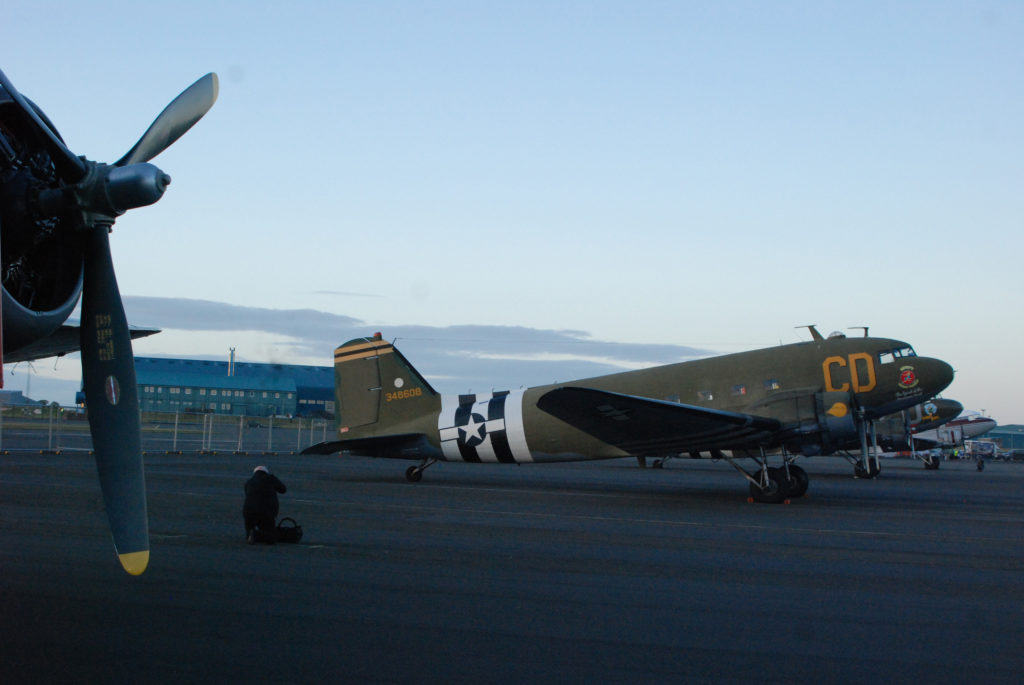
The end of WW2 left Europe’s surface transportation networks in chaos and the Air Service Command C-47s remained in demand through 1945 for logistics deliveries, the evacuation of wounded and the movement of freed allied prisoners of war. The US State Department had been anticipating an opportunity to spread American aviation influence and, as early as September 1944, a letter to General Arnold suggested that the Air Transport Command and Air Service Command should initiate routes to European cities which involved US interests. Other countries, Britain notably, were less keen when the European Air Transport System was established with bases at Frankfurt, Budapest, Lisbon, Stockholm, Paris and Naples plus Prestwick and Heston.
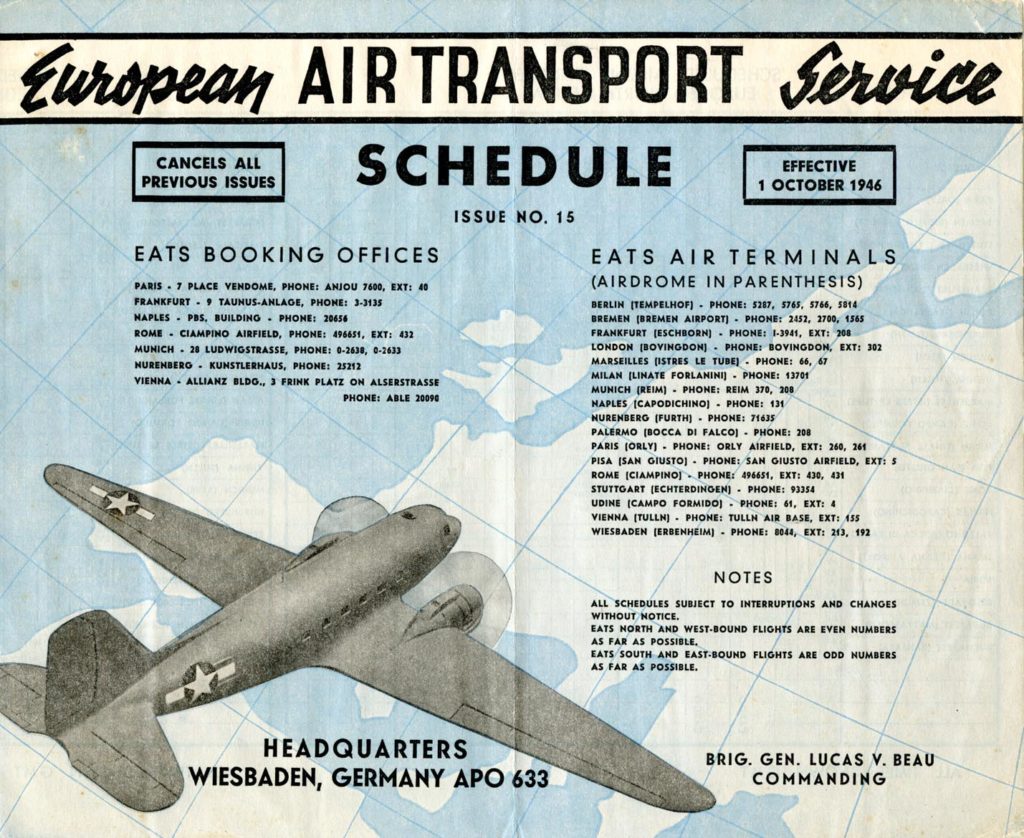
However, by mid- December 1945, 302nd Air Transport Wing had been inactivated and the bulk of the USAAF units in Europe had started their westerly journey on ‘Homebound Airlines’. Troop Carrier Groups transferred 256 C-47s to the Air Transport Command to assist with this repatriation.
In 1946 strategic alliances were being formulated to strengthen post-war Europe. NATO was not formed until 1949 and, in parallel with the alliance, the Mutual Defence Assistance Programme was set-up to supply European forces with US hardware. Even before this, USAAF aircraft had been transferred to the reinvigorated European air forces and Betsy’s Biscuit Bomber was one of 17 C-47s loaned to the Belgian Air Force from 18th April 1946. By July 1946 Betsy had become K-11 of 367 Squadron, part of 169 Wing. With squadron markings L CW, 367 Squadron enabled training of some of the first Belgian paratroops.
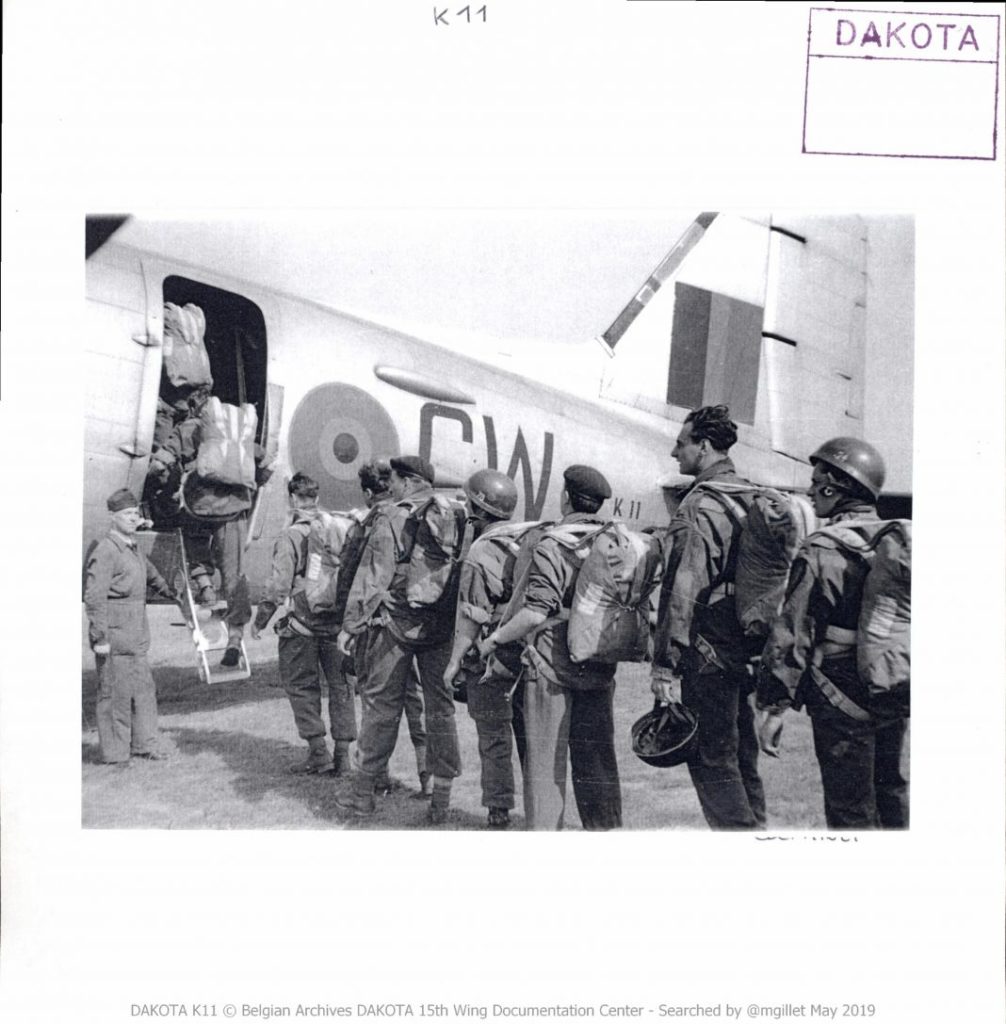
In 1947, K-11 was overhauled at the Avions Fairey facility at Gosselies, near Charleroi. Returning to service, K-11/ Betsy was involved in the 1948 reorganisation of the Belgian Air Force. 367 Squadron became 21 Squadron, part of 15 Wing, as the number of Belgian Dakotas was supplemented with ex-RAF aircraft following upgrading by Scottish Aviation. With identity OT-CWF, Betsy served on until 18th September 1952 when she returned to the Military Assistance Advisory Group of what was now the USAF.
In 1950 President Truman had provided MAAG assistance and US hardware to the French government fighting the Viet Minh in Indochina and, by 1953, there had been a notable step-up of equipment supply from $10 million to hundreds of millions of dollars. Betsy was supplied to L’ Armee de l’air on 8th May 1953 as 348608 under the Mutual Defence Assistance Programme. The ‘new’ registration is the same as ‘Betsy’ had worn on her tail during USAAF service with the ASC.
Betsy was initially delivered to Groupe Transport 1/ 61, ‘Toraine’ Squadron at Orleans in 1953. She was allocated the call sign ‘FRAMB’. This changed to FRBGM after her delivery to Groupe Transport 2/ 64 ‘Anjou’ Squadron at Gia Lam, Hanoi, French Indochina, on 12th April 1954. The French Air Force had used C-47s to good effect for paratroop operations during 1953 but were, nonetheless, sustaining losses at the hands of the Viet Minh. In an attempt to halt a Chinese-supported Viet Minh offensive on the town of Lai Chau, French paratroops were deployed in November 1953 to the airstrip in the Dien Bien Phu valley. An unexpectedly heavy artillery offensive by the Viet Minh led to the French garrison being besieged and the airstrip over-run. Air drops by the French Air Force now kept the Dien Bien Phu troops going as the assault became a siege. By April, when Betsy was delivered to Hanoi, the end of the siege was imminent and, on May 7th 1954, the French Forces surrendered. By July 1954, the French Government had signed the Geneva Accords and France’s tenure in Indochina was at an end. 348608/ Betsy departed Saigon on 1st July 1954 for the 6-day flight back to the main supply and storage base of L’Armee de l’Air at Orleans. She was reassigned to GT1/61, which had been renamed Escadron de Transport 1/61 (ET1/61) in 1953. From here, she was transferred to Centre d’Instruction des Equipages de Transport (CIET) 340 which, along with CIET 341, was a training squadron for transport and logistics operations. Her tenure with CIET 340 lasted from July 1954 to 5th March 1956. There then appears to have been a brief gap before delivery to GT2/ 61 (possibly named ET2/61?)at Orleans on 16th October 1956. The French Air Force does like to store its aircraft in rotation to keep operation hours low, so this might have been a fallow period. This system would have promoted Betsy’s low total hours. From GT2/61 she moved to GT2/ 64 ‘Maine’ squadron and her call sign switched from ‘FRAOO’ to ‘FRAOL’. Another move, on 10th June 1959, saw her with GT1/64 at Le Bourget using the call sign ‘FRAKH’. Betsy was on the move again on 20th April 1960, with assignment to Escadrille de Liasons Aerienne (ELA) 47 at El Aouina, Tunisia where she sported the call sign ‘FSDFI’. On 6th January 1962 there was a move along the North African coast from Tunisia to Algeria with allocation to the Groupe de Liasons Aeriennes (GLA) 45 at Boufarik Air Base around 20 miles south-west of Algiers. With call sign ‘FSCDM’ she was based here until 12th February 1962 before returning to L’Entrepot de l’Armee de l’Air (EAA) 601 at Chateaudun for a ‘rest period’ until 18th June 1962. From Chateaudun she returned to Algeria, this time with the Groupe Saharien de Reconnaissance et d’Appui (GSRA) 78 at Colomb Bechar, a desert air base some 35 miles from the border with Morocco. From 31st January 1963, Betsy was back at Boufarik Air Base, again with GLA 45 but reportedly now with call sign ‘FSCDN’. Finally, she was with EPAS 325, again at Colomb Bechar, during March 1964. The Algerian postings are interesting as, from summer 1962, Algeria was a country independent from France after a protracted civil war. At the end of her North African tours, Betsy returned to EAA 601 at Chateaudun where she remained until the French Air Force sold her to the Israeli Defence Force in 1967.
References: Much of the above information is from JMG Gradidges book ‘The DC-3 and its Predecessors’ published by Air Britain. Some of that detail is probably from the French branch of Air Britain magazine ‘Le Trait d’Union’. There was some extra information on the website www.aviation24.be and in Darrell Knight’s ebook ‘Buffalo Airways’.
After a peaceful spell in Belgium and skirting around small wars and insurrections in Indochina and Algeria, Betsy was propelled straight into a combat zone with her sale to the IDF. Israel had used C-47s in her air force since the country’s formation in 1948 in transport, crop spraying, paratroop and even bombing roles. In January 1967, took the opportunity to double their fleet by buying 15 Dakotas from the French Air Force- fortunate timing as the 6-day war was imminent and, after that conflict, France imposed an arms embargo. The aircraft were delivered to Israel Aircraft Industries for refurbishment and overhaul before many, including Betsy, were assigned to 120 Squadron at Lod Airfield. Betsy arrived on 25th January 1967 and, registered 4X-FNN / 016 her function with 120, the ‘International Squadron’, was to operate flights to foreign destinations to collect freight and transport personnel. She would have seen action during the 6-day War with air supply drops to Israeli forces in the Negev and Sinai deserts, although the IDF hadn’t used paratroops in combat since 1956. During the early seventies, the C-47 fleet was reduced and, on 1st June 1971, Betsy was transferred to ‘The Dakota Squadron’ at Lod. She was one of only ten Dakotas still employed by the start of the October 1973 Yom Kippur War but, again, saw active service probably on casualty evacuation missions but possibly in an electronic countermeasures role. The aircraft was finally officially withdrawn from use in May 1999 although she may have been ‘hot stacked’ at Tel Aviv from August 1993 with a total time of 9357 hours and engines subsequently run for maintenance reasons only.
The proprietor of Global Aircraft Industries in Canada had good relations with Israel and had spent many years combing the World for aircraft suitable for sale or spares. Abe Silverman was born a Romanian, had lived through the Holocaust and made his home in Canada where he formed Denny’s Aero in 1983 at Villeneuve Airport, around 10 miles north-west of Edmonton. Changing name to Global in 1986, he had managed to build the company into one of the top 10 aviation salvage companies by the time he sold up in 2016. He bought six redundant Dakotas from the IDF and added them to the US register for the ferry flight. Betsy was registered N47SJ on 26th August 1999 but didn’t depart from Israel until two years later. An Atlanta-based company was employed to ferry the six aircraft to Canada and they aimed to achieve the transit in an ambitious 54 hours. Additional fuel was carried in 14x 205 litre drums but the means of fuel delivery isn’t known. There were certainly some exciting fuel issues when Betsy commenced her flight home: leaving Israel on 16th August 2001 with a first scheduled stop at Malta, fuel problems commenced some 200 miles short of Luqa Airport. The crew managed to fly for two hours on just the port engine before safely landing at Malta with only a couple of minutes fuel left. Betsy departed Luqa at 07:00 on August 18th, and was reported passing through Aberdeen later that day (surprising, Prestwick would have been the more obvious destination). Further transatlantic stops included Iceland, perhaps Goose Bay, and Manitoba before reaching Villeneuve.
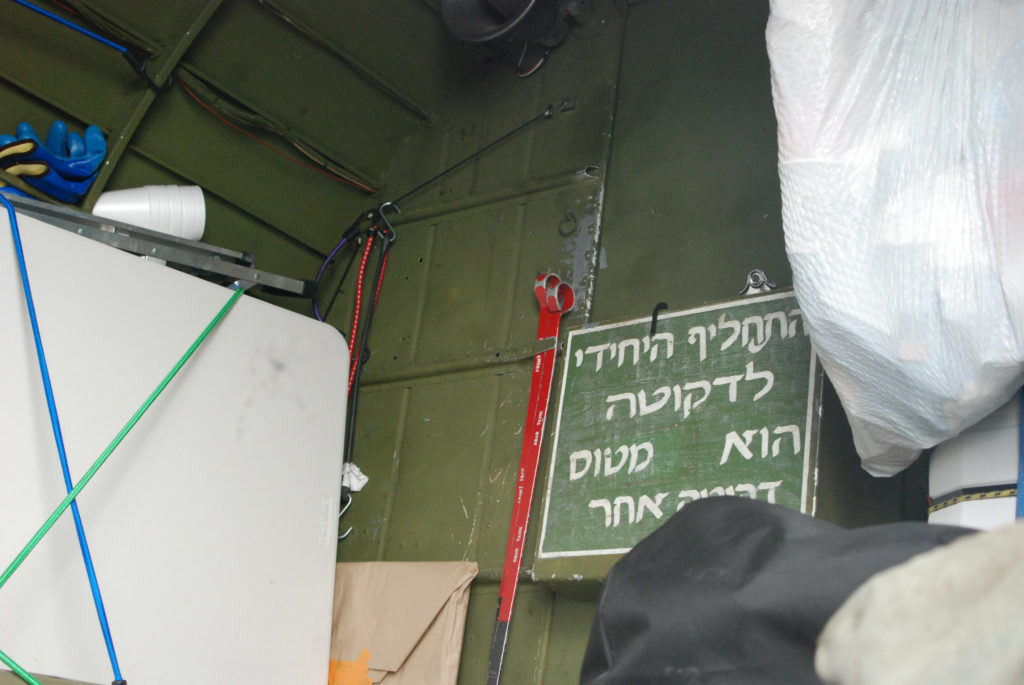
Abe Silverman found buyers for three of the IDF C-47s at a reported price of around $120,000 each.
N751A (42-92277) went to Oklahoma Airborne Museum at McAlester; N155JM (41-18401)went to Ozark Airlines Museum, StLouis, Missouri; N15SJ joined Aero Enterprises at Farmingdale, New York.
The three remaining C-47s were:
N215CM (43-49532) with Total Time of 17,568 hours, N269LM (43-48793) with 21,520 hours and Betsy, N47SJ, with her amazing 9400 hours Total Time. By September 2004, the asking price for each C-47 was reported to be $150,000, potentially still quite a bargain for a low time airframe which had never been civilianised.
By the turn of the century, Glen Thomson, a former simulator instructor with Western Airlines, and Betty Miller were working with Gary Corippo to expand the Estrella Warbirds Museum which had been established at Paso Robles, California, in 1992. Glen had previously established the Estrella Squadron of the Confederate Air Force and harboured an ambition to acquire a C-47 to restore to full flying condition. To this effect, he formed what is, today, the Gooney Bird Group and contributed an initial $20,000 towards acquisition of a suitable C-47. When Global Aircraft Industries were approached, they were less than impressed with the initial offer. Subsequently, in 2007 a deal was struck at $70,000 and work commenced to get Betsy into ferry-worthy condition once again. A permit was issued for the single flight from Edmonton to Paso Robles and she was delivered in May of that year. Betsy was converted to a DC3C-R-1830-90C on 6th July 2009 as part of the extensive renovation required to bring her to flying condition in August 2009 in time for the 2010 Oshkosh C-47 Fly-In. In honour of Glen Thomson’s wife, Betsy, she was named ‘Betsy’s Biscuit Bomber’ and painted with her characteristic nose art. Glen Thomson died in January 2010 at the age of 80, but his aircraft went on to be voted ‘Most Original C-47’ at the Oshkosh event. There are some excellent pictures of the restoration featured on the site sanluisavionics.com
Note: some sources say the C-47 was sold to the GBG for $90k, flown to Paso Robles in June 2008 and restored over a 2-year period.
Paso Robles and Estrella are proud hosts to Betsy and the Museum has been voted Paso Robles’ #1 attraction by Trip Advisor. And this is up against competition like the Pioneer Museum which exhibits 989 different types of barbed wire….
It has been estimated that Betsy’s flying costs are in excess of $1300 per hour but, since returning to flying condition, she has appeared at many air shows across the USA including 2017’s ‘Thunder over Michigan’ event. Here, her operators met with Placid Lassie’s owners, The Tunison Foundation, and BBB was invited to join the 2019 Atlantic Crossing as part of D-Day Squadron.
On her transatlantic adventure, Betsy’s team included Sherman Smoot, Chief Pilot, Shane Wallace, Hector and Nick Camacho, Ben McCall and Bill Frost as pilots. Shane is an aerospace engineer, Nick a mechanical engineer and Sherman Smoot used to fly Phantom F-4s from carriers in the Gulf of Tonkin. More recently, Sherm flew for Continental Airlines and now owns the Bellaluna Winery in Templeton near Paso Robles. One of his notable wines is ‘Fighter Pilot Red’. Scott Stelzle combined pilot and Crew Chief duties and John Doyle was the Chief Mechanic.
Note: Of the original six IDF Dakotas delivered to Edmonton, the recent history has been given for four. Of the remaining two, N215CM was eventually sold to the American Aeronautical Museum of Camarillo and departed Canada on 22nd September 2008. N269LM was damaged in a storm and cannibalised for spares: the nose went to Buffalo Airways and the centre fuselage to Minnesota Museum. Details from Michael Prophet on the dc3hangar.com site.
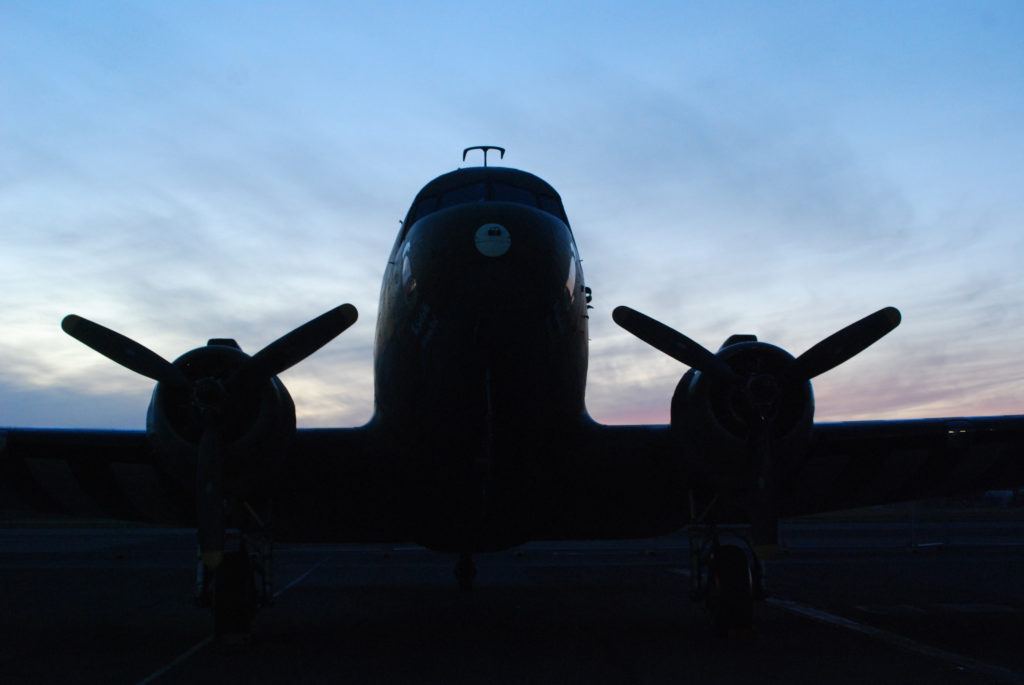
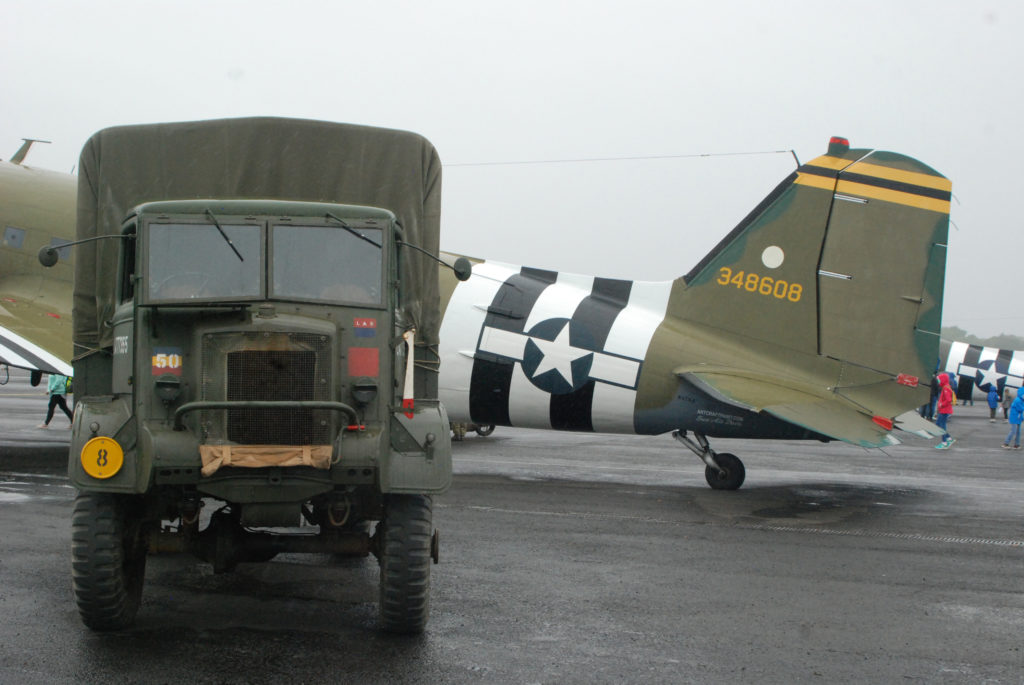
Betsy’s Travel to Europe with D-Day Squadron.
Betsy departed her home base of Paso Robles on May 3rd 2019 en route to Chino, California. On May 6th she left Chino for St.Johns, Arizona. Her next hop was from St.Johns to Wichita, Kansas, and on to Frederick, Maryland on May 9th. On May 13th she reached the D-Day Squadron’s assembly point at Oxford, Connecticut. On May 18th she proudly took her place as part of the New York flypast of Manhattan and the Statue of Liberty.
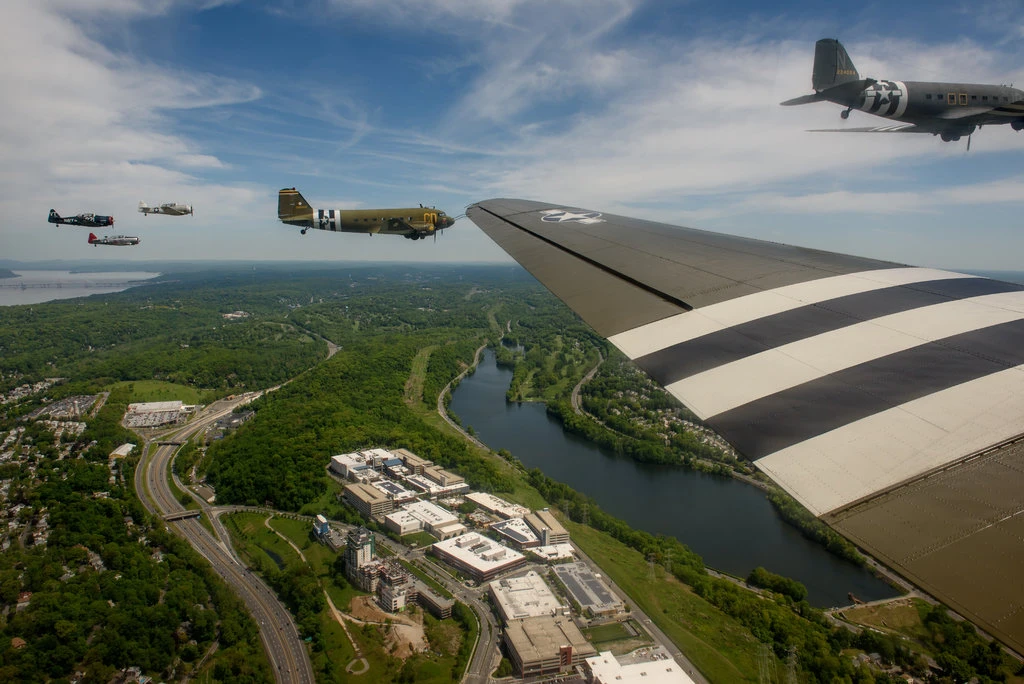
Betsy’s Travel to Europe with D-Day Squadron.
The following day, May 19th, she was on her way from Oxford to Presque Isle, Maine, then on to Goose Bay with her D-Day Squadron pals on the start of her Blue Spruce Route to Prestwick, Scotland.
Bad weather at Goose Bay came as an introduction to the Northern Route’s climate problems and the group were socked-in until May 22nd when they were able to fly on to Kangerlussuaq (also known as Sondre Stromfjord) in Greenland. From there, Betsy transited to Reykjavik on 23rd before the longest over-sea leg to Prestwick the following day. She was safely on the ground in Scotland at 19:02 on May 24th having successfully crossed the Atlantic again.
Betsy participated in the photo evening at Prestwick on May 24th and the somewhat damper Open Day the following day. Along with five of her Squadron compatriots, Betsy departed Prestwick en route for Duxford on Tuesday May 28th. Take-off was at 10:41, arrival at Duxford at 12:47 and the two hours of flight were brilliantly documented by webcam on their facebook feed: facebook.com/watch/?v=458902728213855.
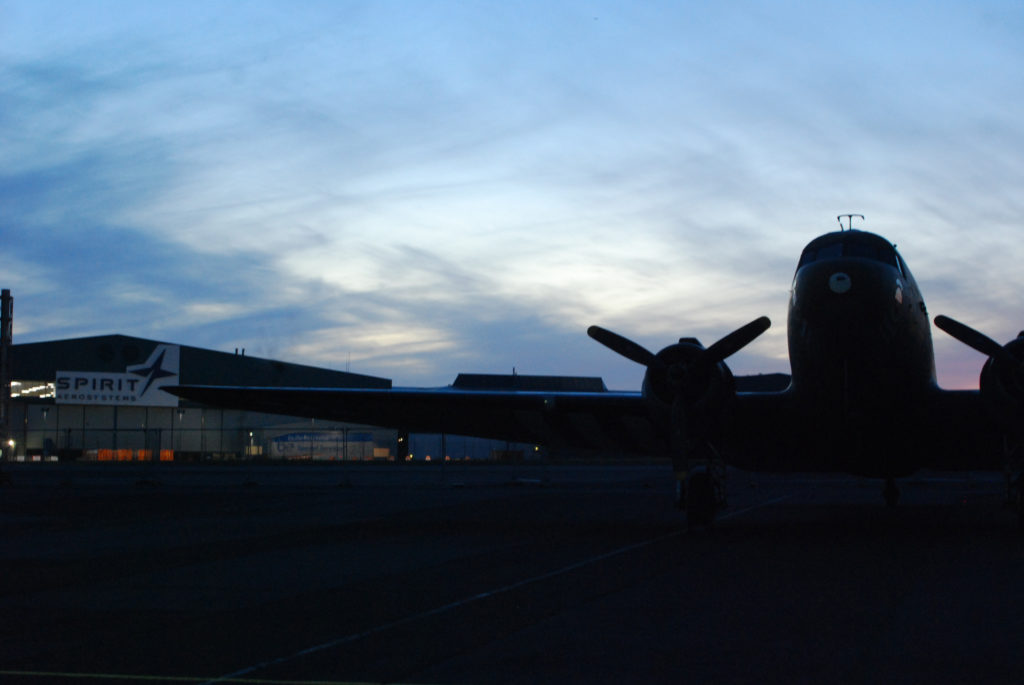
The D-Day squadron gathered at Duxford over the next few days and, on June 1st, seven of the group flew-in to the Shuttleworth Open Day at nearby Old Warden airfield. Betsy was one of the visitors and their airmanship landing on a very short grass strip was rewarded by an excellent day. Further flying followed at Duxford on June 4th before the channel crossing commemoration on June 5th.
Betsy made four flights on June 5th: having positioned to Caen Carpiquet, she flew back to Duxford and, on the afternoon of 5th, returned to France. The commemorative jumps are well-documented on the net and in the European press as are the June 6th flights. On June 7th, Betsy made a positioning flight from Caen to Cherbourg and made another excellent in-flight video which can be found at www.facebook.com/gooneybirdgroup/videos/954278184742945/?t=38. A further parachutist flight took place at Ecausseville on June 8th and one more at LaFiere on 9th. Following this last drop, Betsy departed for Wiesbaden, Germany. The highly successful stay at the US Air Base lasted until June 13th when she flew to Schoenhagen, Berlin. On 14th June she travelled to Fassberg in preparation for the following day’s Berlin Air Lift commemorative fly past. Betsy was honoured to carry Gail Halvorsen, the original Candy Bomber.
Betsy returned to Duxford prior to her return across the Atlantic. Departing Duxford on June 20th, she fuel-stopped at Wick in Northern Scotland en route to Reykjavik, Iceland. The following day, the crew set-off westwards but, with a poor weather forecast, elected to return to Reykjavik. June 22nd was fairer and Betsy headed for her next stop in Greenland before flying on to Presque Isle, Maine, USA. Flying south from Presque Isle, Betsy arrived back at the original D-Day Squadron assembly point at Oxford, Connecticut. Heading steadily westwards, Betsy reached Stearman Field, Benton, Kansas (just outside Wichita) on June 25th. Betsy remained in Wichita with a visit to Eisenhower Field on June 29th. By July 1st, Betsy was at the small municipal airport at Gardner, Kansas before pushing on to Cody, Wyoming, in time for July 4th. Finally, Betsy arrived home at the Estrella Warbird Museum, Pasa Robles, California to a big welcome on July 10th. Despite having flown another 130 hours on the D-Day Squadron project, Betsy is still a low time girl! Thanks for coming to Europe, it was great to meet the crew and see their wonderful aircraft.
Hits: 2095
